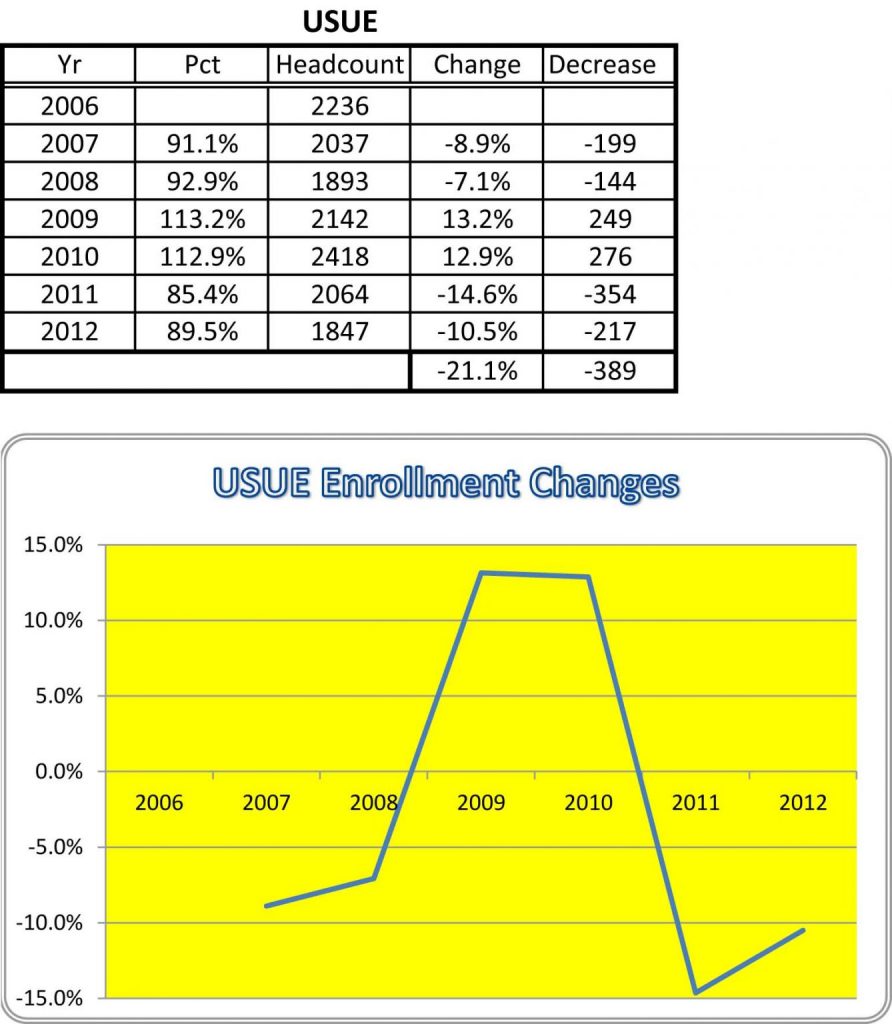Enrollment decrease

Since 2008, Utah’s public higher education institutions have seen record enrollments and were up nearly 18 percent in that time. The first “snapshot” of college enrollments (fall semester, third week) shows that the number of students enrolled at Utah’s colleges and universities held steady with a slight net decrease for the fall of 2012. The Utah System of Higher Education (USHE) enrollment for the Fall 2012 semester decreased by 38-full-time equivalent students, for a net decrease of less than one-half of 1percent from 2011. Four of the eight institutions saw increases between 1.9 percent and 3 percent, while the other four saw decreases ranging from 1.2 percent to 3.1 percent.
At USU Eastern, enrollment was down 200 students after the college discontinued concurrent enrollment in some areas in the state, and lost another 300 due to last year’s small freshman class who went on to become sophomores this year. Those numbers account for the 476-student drop from 2011 to 2012. In 2011, USU Eastern’s headcount was 2,323, in 2012 it was 1,847 students. Full-Time Equivalent student enrollment went from 1,419 in 2011 to 1,284 in 2012.
The bright spot in USU’s enrollment is the 901-student freshman class this year which is 444 more students than last year at this time. Because the freshman class numbers of 456 students in 2011 was so small, it articulated to this year’s small sophomore class.
Greg Benson, vice chancellor for academic affairs & student services, explained some USHE institutions reduced their concurrent enrollment partnerships this year to focus on schools in their respective service areas. Eastern Utah continues to serve Carbon, Pinnacle, Emery, San Juan, and Rich high schools. Partnerships with some high schools on the Wasatch Front and other rural areas were ended by Eastern, with the hope they will be served by colleges closer to them. “This was a strategic choice on our part to better focus on our region and our students.”
“A significant number of students and revenue comes from broadcasting our [USU Eastern] classes to the RCDE sites, including the Logan campus,” Benson said. “Even though we do not count the students we teach at the regional and Logan campuses in our headcount Eastern receives a portion of the tuition generated by each student at those sites, and this can be significant flow of income.”
Another entity growing at USU Eastern-Price is the upper-division and graduate enrollment. These numbers increased from 106 students to fall 2011 to 137 students in fall 2012.
On the state level, “A few factors may be impacting enrollment. After years of record enrollment growth and the effects of the recession on state budgets, some institutions are at or near capacity—making it difficult for some students to obtain classes. Several institutions have raised academic standards for admission, and with the economy improving, more people are returning to full-time employment,” said Commissioner of Higher Education, Dave Buhler. “To reach Utah’s ‘Big goal’ of 66 percent of adults with a college certificate or degree, we will need more students to enroll and complete their education.”
Total budget-related FTE approximates the number of students enrolled full-time (15-semester hours for undergraduate students; 10-semester hours for graduate students) each semester. That number totaled 110,760 in the fall of 2012, compared to 110,798 in the fall of 2011. Headcount includes all students enrolled at an institution.
Additionally, particularly at institutions with a community college role, USHE serves several thousand students in non-traditional programs, which are not budget-related, do not receive any taxpayer support, and are not included in the third week totals. These include short-term training programs and non-credit technical training. USHE institutions also serve over 30,000 high school students in concurrent enrollment. The following tables show budget-related FTE and total headcount. (Budget-related are enrollments that receive state funding.)




